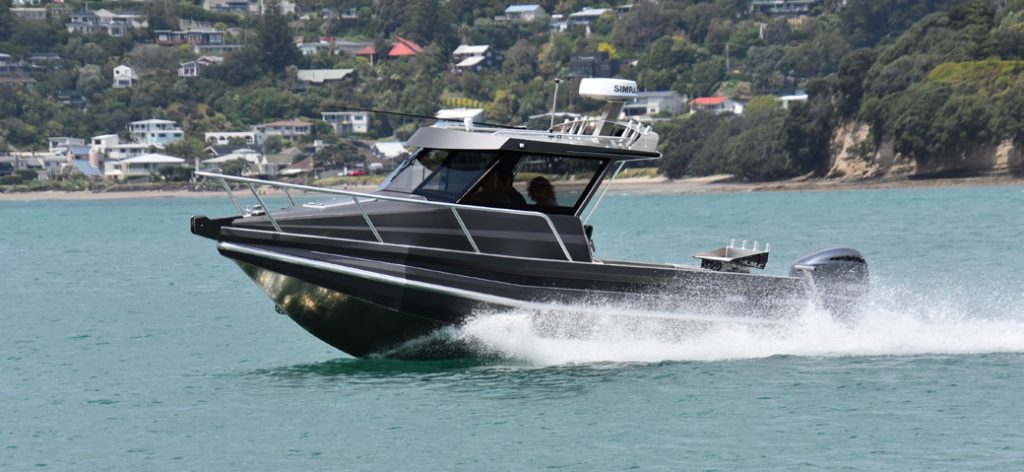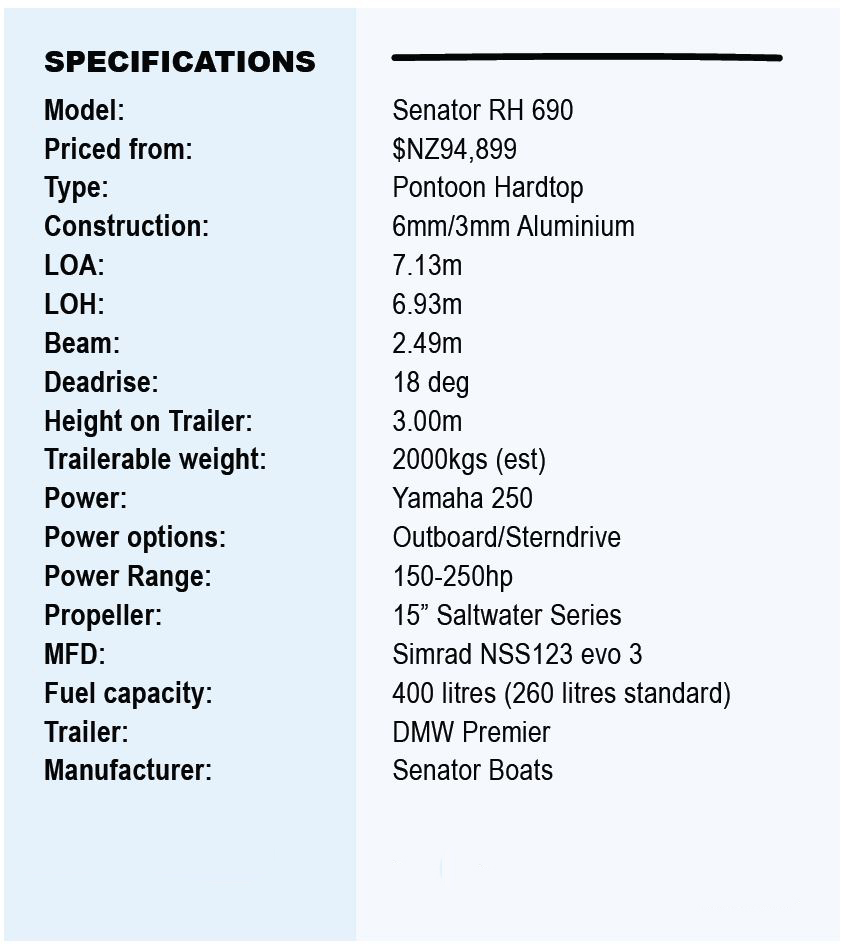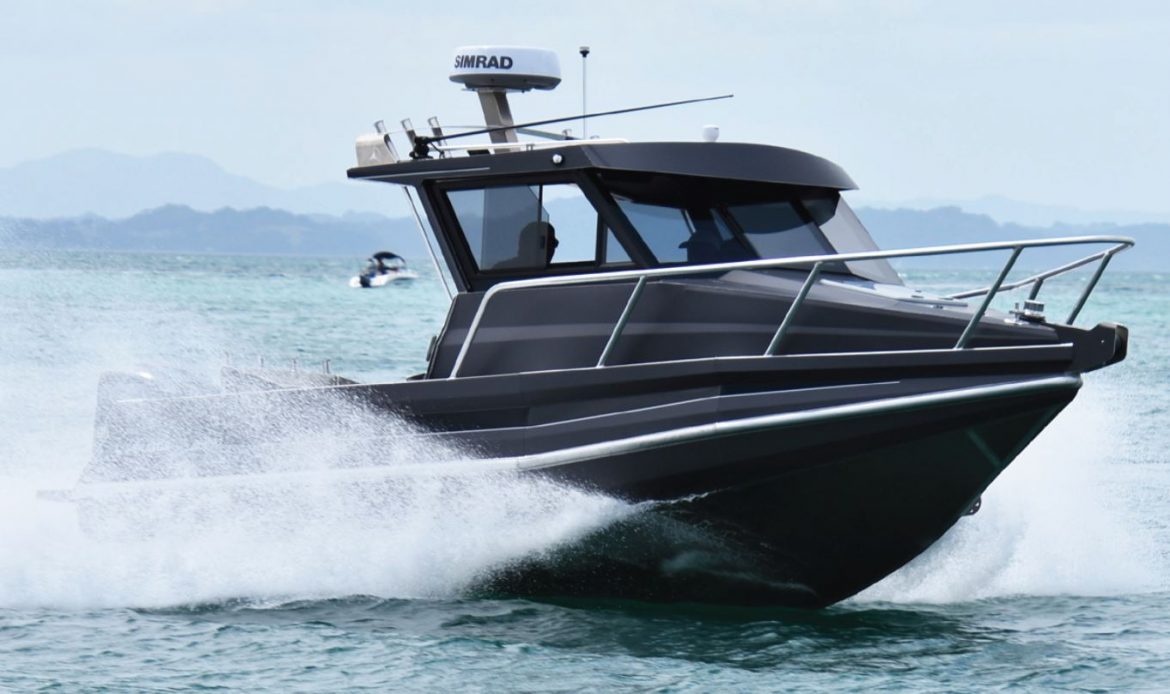Author : Barry Thompson
being a third-time owner of a senator boat, blake masefield knew precisely what he wanted when ordering his new RH690 and after only a few months on the water reckons he’s got a near-perfect boat.
Having previously owned two Senators; an RC 540 and RH 620, he didn’t have to be sold on the ride and handling or the fit out and finish. “I love their boats, and they have never let me down, so I couldn’t see any reason to swap to another brand”, says Blake.
The main reason for the change was he needed something bigger, that offered more space for fishing and was more overnight friendly. “We did everything we could in the 620, and then some, but I always found I needed more workable areas, as we started to get more adventurous with our fishing”.
That includes game fish both on the west and east coasts, so the boat still needed to be trailerable and easily towable. Some of us consider a 45 minute trip from the boat ramp to the 40m mark in the Hauraki Gulf a big trip. However, for Blake and his mates, that’s more a 2-hour pre-dawn run to 20 miles behind Great Barrier chasing bluenose and hapuka or trolling lures for big game.
When you’re heading out ‘extra-wide’, then you not only need a boat capable of handling whatever the sea throws at you but one that you can do in relative comfort, while still considering you are in a 7m boat.

The Senator RH 690 is built to take the tough stuff, with a 6mm hull, 3mm pontoons and a 4mm treadplate floor. Senator has a reputation for the quality of their hull construction, which sees the RH 690 built to survey standards and comes with a 5-year hull warranty. Under the sole and in the pontoons it’s all reserve buoyancy, with all sealed separate buoyancy chambers pressure tested. Technically the RH 690 fully flooded will not sink, but I was not about to test the maths.
More Space
While the RH 690 is a certainly a bigger boat than the RH 620 – 7.13m overall compared to 6.75m overall – it was more about the space internally that was important. Compared to the RH 620, the RH 690 offers more beam and a marginally larger cockpit, which is what Blake was after for fishing. Having a generous size footprint to run himself and a few mates while fishing deep for Hapuka or in the shallows for snapper and kinghies, was a consideration when changing to
the larger model.
While the RH 620 has a total of 4.50 sqm cockpit space, the RH 690 is 2% bigger with 4.60 sqm. The internal beam of the RH 620 is 1.86m and the RH 690 a little more at 1.99m. External beam increases in the RH 690 to 2.49m from the RH 620s, 2.38m. Now that may not all sound like much of a gain, but when you are fishing four guys every little bit helps. Coaming heights are also increased with the 690/770 at 800mm, while the 620/650 is 750mm and they are high enough to allow for two tier storage racks, which is wide enough for dive bottle storage and long enough for 2m rods.
The cockpit features extra-wide flat coamings and a port side walk-through to the boarding platform with two-step drop down alloy dive ladder. There is a live bait tank built under the recess with the customary viewing window and to starboard custom tuna tubes.
The large boat station in the centre of the transom comes with a tackle drawer and four rod holders. While the cockpit is not self-draining, there is a deep sump with a bilge pump to expel any water that comes aboard. With no seating to get in the way, you can fish all corners of the cockpit without interference.


Blake’s RH 690 is the open version (i.e.no rear bulkhead) with the double king/queen seats dividing the open cockpit from the forward helm area. The alloy seat bases have space beneath for cooler bins, or if you want to go to the extra expense Senator will build in more permanent fridge/freezer and galley modules. Being an alloy boat, it’s all a matter of choice.
Speaking of choice, you do have the option of a spacious lockup forward and main cabins by extending the cabin roof back for more internal space or keep it forward, such as in our test boat to maximise the cockpit area. Senator also offer a shorter bunk, longer deck option [200mm] in most of their larger boats, for those more focused on day trips rather than overnighting.
I found the twin swivelling bucket seats well placed to drive when seated and made good use of the footrest. The seat base slides back out of the way if you want to drive standing. Rooftop handrails were also a nice touch. The sliding side windows provide clean airflow, and there is loads of storage space for all the nick-nacks you take out on a trip.
Seriously Simrad
When Blake decided to build the new boat, he also wanted a seriously good electronics package and one that would give him the clarity and functionality for deep water fishing. He chose a Simrad NSS12 evo3 with broadband 4G radar, and a Simrad DrivePilot.
This high-definition 12-inch display delivers a big-picture view of charts, radar, sonar, and more. You can switch eamlessly between the touchscreen and the keypad controls.
The Broadband 4G radar has a range of up to 36nm, so trips in the dark are made a lot safer. Low power consumption, zero radiation hazard, and a compact dome with no external moving parts make this radar system ideal for vessels like the RH 690. Plus, not only can Blake log in and plan those big trips to the back of Great Barrier Island, but they can be supported with automatic routing and let the Simrad Drive Pilot do its thing. Certainly makes the journey a lot more relaxing.
At around 30 knots the NSS12 evo3 was still clear and distinguishable. You could see the fish targets clearly and the bottom contour. With wireless connectivity and HDMI, Blake can even mirror the display to his smartphone or tablet. If he had a TV on board, he could also connect to that as well.
Being a fisherman, it was also crucial that the echo sounder delivered the best possible information through the sonar transducer. This includes Structure Scan HD imaging which provides picture-like views of fish holding structure, while Forward Scan sonar offers a clear view of the bottom ahead. CHIRP-enabled sonar provides reliable bottom tracking and fish-finding performance, including support for dual-channel CHIRP transducers to deliver coverage of multiple depth ranges. You also have the option of utilising dual transducers, which lets you connect multiple transducers to a single display.


I noticed that I was able to view the screen very clearly in bright light, even wearing polarised sunglasses. Being a touch screen, it was easy to monitor and control all of the on-board electronics with simple menus and customisable split-screen layouts. There is also a built-in keypad with a rotary control dial. Interestingly Blake installed the NSS evo3 himself and said it was a reasonably straight forward job.
Alongside the NSS evo 3 screen was the display for the Simrad autopilot which links into the outboards hydraulic-steering. This includes the DrivePilot pack, which is rated for boats below 9m and integrates seamlessly with Simrad multifunction displays.
It is a breeze to operate in both simple and complex manoeuvers. What makes the Drive Pilot so handy for serious fisherman like Blake, is its ability to offer automatic depth contour tracking. Perfect for fishing ledges or drop-offs, and also a great way to cruise along the coastline while automatically maintaining a safe depth beneath your boat.
Overnight Stays
However, it was the need for a more creature comforts when staying overnight, that also attracted him to the RH 690. Okay, so it’s not a big weekender, but there is enough space for Blake and a couple of mates to stay overnight. The forward cabin has two large berths with an infill, a plumbed-in head and storage under the squabs. While two people can sleep in here, a blow-up mattress and sleeping bag will look after a third person in the cockpit. A canvas canopy with side curtains would be a great addition.
Cooking, if it is required, could be handled with a Magma rod mounted BBQ and there is plenty of options for freshwater storage and a handheld shower. A Maxwell capstan winch handles anchoring chores, but I would have chosen a drum winch as they hold a lot more rode and the anchor locker on the RH 690 is big enough to mount one.

Power Plus
Power options for the RH 690 are single or twin outboards and single stern drives. When I ran the RH 690 for the review, we had some reasonably choppy water and about 20 knots of breeze. Like all hardtops of this size, a little tab was required to keep everything on the level. The 18 deg deadrise hull handled the water fine, and although we did take some spray over the deck, the single wiper quickly cleared the tinted safety glass screen. I would like to have seen two wipers as in
heavy rain you often tend to lose sight of what’s coming from your port side.
Top speed was 39.5 knots @ 6000 rpm, using a 15” Saltwater Series propeller. Using at 17” Saltwater Series we did manage to increase the speed to 42 knots and maintained a similar fuel consumption.
The Yamaha 250 packs plenty of punch and acceleration out of the hole is very impressive. A slippery hull onto the plane and very quick to reach maximum rpm.
Best cruise was around 4000 rpm, which gave the RH 690 a speed of 25.5 knots and fuel consumption of 39.5 lph/1.6 lpnm and a range of 220nm, based on 90% of a 400-litre fuel tank.

Pimp my Ride
Senator understands that we all have different needs when it comes to boating so offer countless custom options to give you a choice to keep it real simple or pimp your Senator to the max. While Blake didn’t alter a lot from the standard layout, he did go for an enlarged fuel tank and tuna tubes, plus an upmarket electronics package. Overall a great set up for fishing in almost any conditions.






